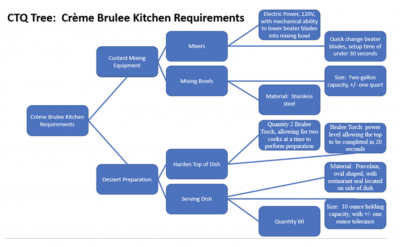
Key Points
- CTQ is an approach aimed at meeting customer needs.
- Implementing this approach allows you to focus on increasing customer satisfaction.
- Proper implementation reduces the amount of work needed to complete a given process.
- The best approach to CTQ relies on trees that break down all steps of a process.
- Implementing this approach is one of the best ways to listen to the voice of the customer.
Think about the aim of any business for just a moment. You aren’t serving your employees, are you? Accordingly, you’re tailoring your product or services to the needs of customers. Implementing Critical to Quality, or CTQ, is a surefire way to identify that you are meeting your customer’s needs.
What is Critical to Quality: An Overview

Critical to quality, also known by the acronym CTQ, are the key attributes of a product or service that your customers have defined as being important. These measurable characteristics are what help us understand what steps in our process are value-added. These critical quality characteristics help define the value.
To understand value-added and non-value-added, we must first understand what the customer values. We need to identify and prioritize who our customers are and collect the VOC, or voice of the customer data. Using this data, we then determine the list of CTQ requirements.
A common tool used to prioritize a specific requirement is called a CTQ tree. This tool helps take customer requirements, which often start broad, and turn them into performance requirements that can be measured.
An Example of CTQ in Action
Think about CTQ in the context of a restaurant. The menu the owner is trying to establish, as well as the level of quality of the food, will impact the equipment required. So, if this was a fine dining establishment that served crème brule, as an example. Subsequently, the kitchen would require a brulee torch for the hardening of the top of the dish. If the restaurant is a burger joint, a brulee torch is useless.
The kitchen manager must understand the customer’s needs before setting up a kitchen that can meet those needs. Maybe they are making hundreds of crème brulee a day for delivery to local shops. So, a traditional crème brulee torch would not be practical. Instead, some automatic machine that can harden the tops of thousands of crème brulee a day is required.
All the characteristics of the customer are needed to establish what is critical to quality.
A CTQ for the making of the crème brulee might look like the example below:

The CTQ tree helps take the initial customer desires and turn them into measurable deliverables.
Pros for Implementing CTQ
Before you feel tempted to shrug off this step, deeming it unnecessary, consider a few key ways it can benefit you to consider what is critical to quality.
Making It Possible to Understanding Your Customer’s Needs
If you don’t know the characteristics that make up your customer’s products or services, how can you be expected to make your customer happy regularly? Knowing the CTQ information makes it possible to understand value, eliminate non-value-added activities, and satisfy your customers.
Less Work
When you do not understand the CTQ, you are bound to fail to meet your customer’s requirements, and thus your process will require rework. When you’ve established the metrics using your CTQ trees, you can spot your quality errors sooner, decreasing the cost of rework.
Saves Time
Less rework also means less time spent performing the rework and less time trying spent apologize to the customer regarding errors.
Best Practices for CTQ

1. Collect as much data regarding the CTQ as possible. It’s easy to overlook key customer requirements.
2. Ask the customer the same questions, but in different ways. You will often find that a reworded question will get you a slightly different response that may shed additional light on a hidden requirement.
3. Remember to use your CTQ trees to help you develop your metrics. Quality is maintained through the metrics you set up, both for verifying that customer demands are being met and for identifying errors as soon as possible.
RELATED: CRITICAL TO QUALITY VS. CRITICAL TO CUSTOMER
Breaking Down CTQ: A Basic Approach
Consider a laptop for just a moment. The Apple MacBook line is a customer favorite and Apple’s approach to CTQ is worth considering. As such, let’s take a look at the Silicon laptops. What are the important factors we consider with a laptop? It needs enough power to handle basic tasks, it needs to have good battery life, and the screen needs to be clear and sharp.
If we built a CTQ tree around a MacBook, you would have each of these criteria broken down into single points. From there, you would dive further in-depth into the processes and equipment required to fulfill these criteria.
Listening to Your Customers
CTQ is just one approach to meeting your customer’s expectations. To fully understand the needs and wants of your customers, you need to understand the voice of the customer or VOC. Find out how this concept applies to your processes in our top-down guide.
If you’d like to see an in-depth real-world application of CTQ, VOC, and other Six Sigma concepts, then you owe it to yourself to read about how Samsung has implemented these tools to become a global leader in technology.
Critical to Quality Is Vital for Customer Demands
Critical to quality describes the key characteristics needed to meet customer demands. These should be measurable factors, developed from the Voice of the Customer exercises. It is important to collect as much data as possible from the customer, and then transform that data into key deliverables.
By measuring the key metrics, you can be sure to spot errors earlier in the process and make your customer happy by meeting their expectations.